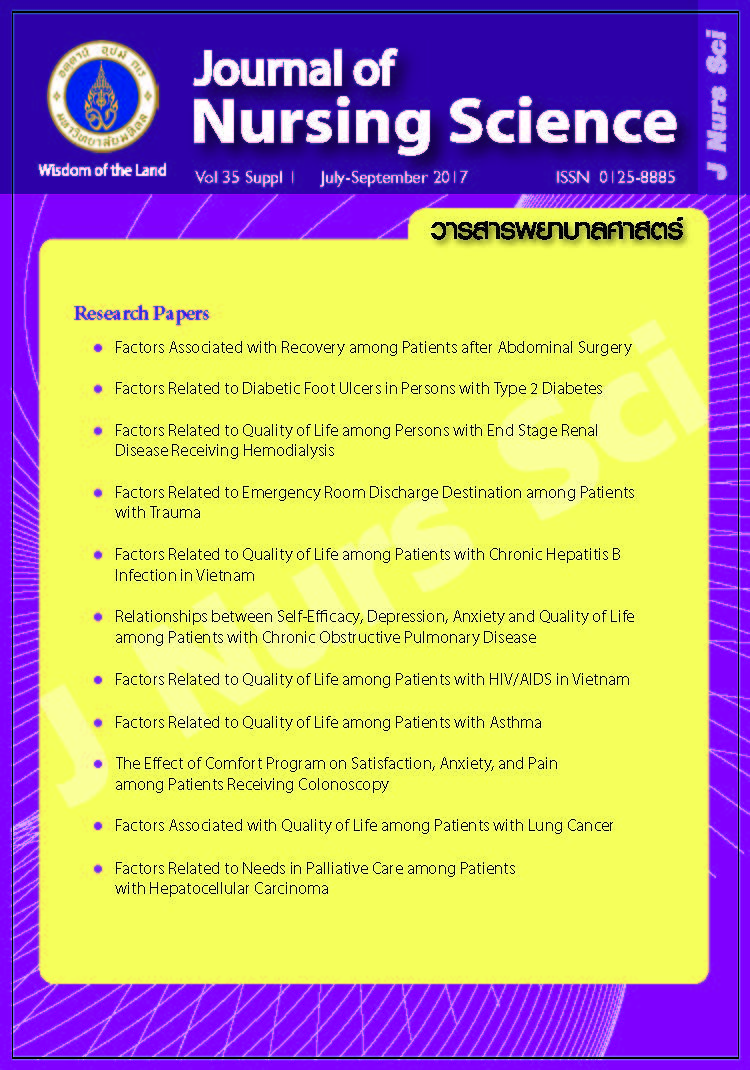Factors Related to Quality of Life among Persons with End Stage Renal Disease Receiving Hemodialysis ปัจจัยที่มีความสัมพันธ์กับคุณภาพชีวิตของผู้ป่วยไตวายระยะสุดท้ายที่ได้รับการรักษาด้วยการฟอกเลือด
Main Article Content
Abstract
Purpose: To determine the relationships between co-morbidity, social support, symptom status, and quality of life among persons with end stage renal disease receiving hemodialysis.
Design: Descriptive correlational research.
Methods: The sample composed of 115 persons with end stage renal disease receiving hemodialysis in a tertiary care hospital in Hanoi, Vietnam. Data were collected using the patients’ hospital record and interview with 3 questionnaires: The Multidimensional Scale Perceived Social Support, the Edmonton Symptom Assessment System Scale, and the Kidney Disease Quality of Life-Short Form 36 Scale. Spearman’s Rho was employed to test the relationships among variables.
Main findings: The findings revealed that the average score of quality of life among persons with end stage renal disease receiving hemodialysis was 45.53 (SD = 13.20), 62.61% of those had score of quality of life below average level. Co-morbidity and symptom status were negatively related to QOL (rs = - .46, - .67, p < .05). Social support was positively related to quality of life among persons with end stage renal disease (rs = .63, p < .05).
Conclusion and recommendations: In order to improve quality of life among persons with end stage renal disease receiving hemodialysis, it is recommended that nurses should assess and manage patients’ symptoms, control their co-morbidity, and seek appropriate resources to support them.
บทคัดย่อ
วัตถุประสงค์: เพื่อศึกษาความสัมพันธ์ระหว่างโรคร่วม การสนับสนุนทางสังคม และอาการที่สัมพันธ์กับโรคไตวายระยะสุดท้าย กับคุณภาพชีวิตของผู้ป่วยไตวายระยะสุดท้ายที่ได้รับการรักษาด้วยการฟอกเลือด
รูปแบบการวิจัย: การวิจัยเชิงสหสัมพันธ์
วิธีดำเนินการวิจัย: กลุ่มตัวอย่างประกอบด้วยผู้ป่วยไตวายระยะสุดท้ายจำนวน 115 คนที่ได้รับการรักษาด้วยการฟอกเลือดด้วยเครื่องไตเทียมที่หน่วยโรคไต โรงพยาบาลระดับตติยภูมิแห่งหนึ่งในกรุงฮานอย ประเทศเวียดนาม เก็บข้อมูลเกี่ยวกับลักษณะส่วนบุคคล การวินิจฉัยโรค โรคร่วมและการรักษาจากแฟ้มประวัติของผู้ป่วย และใช้แบบสอบถาม 3 ชุดในการสัมภาษณ์ผู้ป่วย ประกอบด้วย แบบสอบถามการสนับสนุนทางสังคม แบบสอบถามอาการที่สัมพันธ์กับโรคไตวายระยะสุดท้าย และแบบสอบถามคุณภาพชีวิตของผู้ป่วยโรคไต ใช้สถิติ Spearman’s Rho ในการวิเคราะห์ความสัมพันธ์ระหว่างตัวแปรต้นและตัวแปรตาม
ผลการวิจัย: กลุ่มตัวอย่างมีค่าเฉลี่ยระดับคะแนนคุณภาพชีวิตเท่ากับ 45.53 ส่วนเบี่ยงเบนมาตรฐานเท่ากับ 13.20 ร้อยละ 62.61 ของกลุ่มตัวอย่างมีระดับคะแนนคุณภาพชีวิตต่ำกว่าค่าเฉลี่ย การมีโรคร่วม และอาการที่สัมพันธ์กับโรคไตวายระยะสุดท้าย มีความสัมพันธ์ทางลบกับคุณภาพชีวิต (rs = - .46, rs = - .67) การสนับสนุนทางสังคมมีความสัมพันธ์ทางบวกกับคุณภาพชีวิต (rs = .63)
สรุปและข้อเสนอแนะ: เพื่อส่งเสริมคุณภาพชีวิตของผู้ป่วยโรคไตวายเรื้อรังระยะสุดท้ายที่ได้รับการรักษาด้วยการฟอกเลือดด้วยเครื่องไตเทียม พยาบาลควรประเมินและจัดการกับอาการที่สัมพันธ์กับโรคไตวายระยะสุดท้าย ควบคุมความรุนแรงของโรคร่วมและแสวงหาแหล่งสนับสนุนที่เหมาะสมให้กับผู้ป่วย
Article Details
Copyright Notice: Nursing Science Journal of Thailand has exclusive rights to publish and distribute the manuscript and all contents therein. Without the journal’s permission, the dissemination of the manuscript in another journal or online, and the reproduction of the manuscript for non-educational purpose are prohibited.

Disclaimer: The opinion expressed and figures provided in this journal, NSJT, are the sole responsibility of the authors. The editorial board bears no responsibility in this regard.
References
2. Tsay SL, Healstead M. Self-care self-efficacy, depression, and quality of life among patients receiving hemodialysis in Taiwan. Int J Nurs Stud. 2002;39(3):245-51.
3. Son YJ, Choi KS, Park YR, Bae JS, Lee JB. Depression, symptoms and the quality of life in patients on hemodialysis for end-stage renal disease. Am J Nephrol. 2009;29(1):36-42.
4. Chan R, Brooks R, Erlich J, Chow J, Suranyi M. The effects of kidney-disease-related loss on long-term dialysis patients' depression and quality of life: positive affect as a mediator. Clin J Am Soc Nephrol. 2009;4(1):160-7.
5. Drayer RA, Piraino B, Reynolds CF 3rd, Houck PR, Mazumdar S, Bernardini J, et al. Characteristics of depression in hemodialysis patients: symptoms, quality of life and mortality risk. Gen Hosp Psychiatry. 2006;28(4):306-12.
6. Khanh NV, Duangpaeng S, Deenan A, Bonner A. Examining the health-related quality of life of people with end-stage kidney disease living in Hanoi, Vietnam. Renal Society of Australasia Journal. 2012;8(3):140-5.
7. Bonner A, Caltabiano M, Berlund L. Quality of life, fatigue, and activity in Australians with chronic kidney disease: a longitudinal study. Nurs Health Sci. 2013;15(3):360-7.
8. Theofilou P. Association of insomnia symptoms with kidney disease quality of life reported by patients on maintenance dialysis. Psychol Health Med. 2013;18(1):70-8.
9. Almutary H, Bonner A, Douglas C. Symptom burden in chronic kidney disease: a review of recent literature. J Ren Care. 2013;39(3):140-50.
10. Ziegert K, Fridlund B, Lidell E. Health in everyday life among spouses of haemodialysis patients: a content analysis. Scand J Caring Sci. 2006;20(2):223-8.
11. Khalil AA, Abed MA. Perceived social support is a partial mediator of the relationship between depressive symptoms and quality of life in patients receiving hemodialysis. Arch Psychiatr Nurs. 2014;28(2):114-8.
12. Faul F, Erdfelder E, Buchner A, Lang AG. Statistical power analyses using G*Power 3.1: tests for correlation and regression analyses. Behav Res Methods. 2009;41(4):1149-60.
13. Cohen J. Statistical power analysis for the behavioural sciences. New York: Academic Press; 1969.
14. Hays RD, Kallich JD, Mapes DL. Coons SJ, Amin N, Carter WB. Kidney Disease Quality of Life Short Form (KDQOL-SFtm), Version 1.3: a manual for use and scoring. Santa Monica, CA: RAND Corporation; 1997.
15. Lee SJ, Jeon J. Relationship between symptom clusters and quality of life in patients at stages 2 to 4 chronic kidney disease in Korea. Appl Nurs Res. 2015;28(4):e13-9.
16. Tsai YC, Hung CC, Hwang SJ, Wang SL, Hsiao SM, Lin MY, et al. Quality of life predicts risks of end-stage renal disease and mortality in patients with chronic kidney disease. Nephrol Dial Transplant. 2010;25(5):1621-6.
17. Nayana SA, Balasubramanian T, Nathaliya PM, Nimsha Hussain P, Mohammed Salim KT, Muhammed Lubab P. A cross sectional study on assessment of health related quality of life among end stage renal disease patients undergoing hemodialysis. Clin Epidemiol Glob Health. 2017;5(3):148-53.
18. Di Iorio B, Cillo N, Cirillo M, De Santo NG. Charlson Co-morbidity Index is a predictor of outcomes in incident hemodialysis patients and correlates with phase angle and hospitalization. Int J Artif Organs. 2004;27(4):330-6.
19. Van Manen JG, Korevaar JC, Dekker FW, Boeschoten EW, Bossuyt PM, Krediet RT. Adjustment for co-morbidity in studies on health status in ESRD patients: which comorbidity index to use? J Am Soc Nephrol. 2003;14(2):478-85.
20. Davison SN, Jhangri GS, Johnson JA. Cross-sectional validity of a modified Edmonton symptom assessment system in dialysis patients: a simple assessment of symptom burden. Kidney Int. 2006;69(9):1621–5.
21. Lowney AC, Myles HT, Bristowe K, Lowney EL, Shepherd K, Murphy M, et al. Understanding what influences the health-related quality of life of hemodialysis patients: a collaborative study in England and Ireland. J Pain Symptom Manage. 2015;50(6):778-85.
22. Rambod M, Rafii F. Perceived social support and quality of life in Iranian hemodialysis patients. J Nurs Scholarsh. 2010;42(3):242-9.
23. Goldman C. Vietnamese Cultural profiles. An initiative of old partner in culturally appropriate care. West End, Queensland: Diversicare; 2009.

